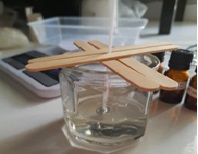Microwave Assisted Hydrodistillation Essential Oil from Lime Peel Waste as Aromatherapy Candles
Abstract
Flavonoids belong to the extensive group of polyphenol compounds. They can function as antioxidants and antibacterials by denaturing bacterial cell proteins and damaging bacterial cells. One source of essential oils is lime peel, which is often discarded and goes unused. The distillation method utilizes microwaves, offering an alternative to conventional distillation techniques and resulting in enhanced effectiveness and efficiency. The Microwave Assisted Hydrodistillation (MAHD) method proves to be more energy-efficient, environmentally friendly, rapid, safe, and cost-effective. This study aims to assess the impact of the MAHD method on the quantity and quality of essential oils extracted from lime peels. Laboratory tests are conducted in accordance with Indonesian national standards. The overarching objective is to establish a process that transforms discarded lime peels into aromatherapy candles, contributing to respiratory health. The MAHD method is employed with a sample mass to distilled water solvent ratio of 1:1. The resulting essential oil undergoes analysis using the GC-MS method. According to the GC-MS test results, the compound with the highest percentage area is limonene at 98%. This is followed by trans-caryophyllene at 99% with a retention time of 12.422, and beta-selinene at 99% with a retention time of 13.191.
Downloads

Copyright (c) 2023 Mariaulfa Mustam, Hijrah Amaliah Azis, Nurfika Ramdani, Nurafdaliana Zalzabila

This work is licensed under a Creative Commons Attribution-NonCommercial-NoDerivatives 4.0 International License.
Authors who publish with this journal agree to the following terms:
- Copyright on any article is retained by the author(s).
- The author grants the journal, the right of first publication with the work simultaneously licensed under a Creative Commons Attribution License that allows others to share the work with an acknowledgment of the work’s authorship and initial publication in this journal.
- Authors are able to enter into separate, additional contractual arrangements for the non-exclusive distribution of the journal’s published version of the work (e.g., post it to an institutional repository or publish it in a book), with an acknowledgment of its initial publication in this journal.
- Authors are permitted and encouraged to post their work online (e.g., in institutional repositories or on their website) prior to and during the submission process, as it can lead to productive exchanges, as well as earlier and greater citation of published work.
- The article and any associated published material is distributed under the Creative Commons Attribution-NonCommercial-NoDerivatives 4.0 International License.





_copy1.png)










